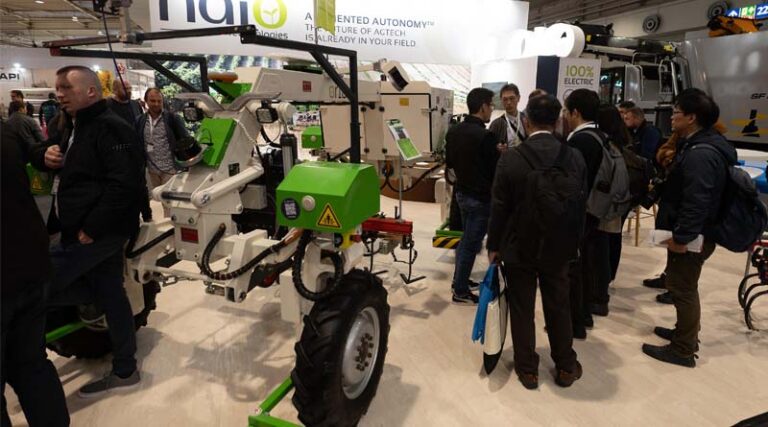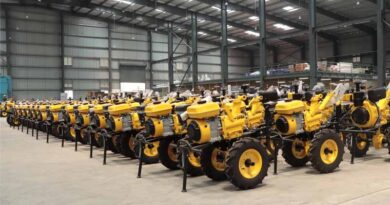
Autonomous Farming in Focus: Agritechnica 2025 to Showcase Next-Gen Robots and Smart Machines in Germany
15 September 2025, Germany: Autonomous and semi-autonomous technologies are rapidly reshaping agricultural practice — and will be a central focus at Agritechnica 2025, the world’s leading trade fair for agricultural machinery, 9-15 November 2025 in Hanover, Germany. From intelligent field robots to retrofit kits for tractors, the trade fair will showcase the latest innovations in automation, robotics, and artificial intelligence (AI) designed to support farmers in an increasingly complex and labor-constrained environment.
Modern agricultural machines are increasingly equipped with technologies such as GPS, sensors, cameras, AI, and machine learning, enabling them to perform tasks with minimal human intervention while remaining under operator supervision. These systems are already being used for precision sowing, weeding, fertilization, and crop protection, and are particularly valuable in specialty crops and organic farming, where manual labor is both intensive and costly.
Today’s field robots can weed with millimeter precision — not only between rows but also within rows — thanks to advanced sensor and camera systems. AI-based image recognition enables them to distinguish between crops and weeds even at the seedling stage.
Although their working speed is low, often just a few kilometers per hour, they can operate continuously, 24 hours a day. Practical experience shows time savings of up to 80 percent compared to manual weeding.
However, switching robots between different crops can be complex and time-consuming, which is why many remain dedicated to a single crop. Full process chain automation is possible with multi-functional platforms like the Tipard 1800, which can handle sowing, fertilizing, weeding, and harvesting — even in fruit production.
At Agritechnica 2025, which is organized by DLG (German Agricultural Society), visitors will experience the full spectrum of autonomous solutions — from market-ready field robots capable of millimeter-accurate weeding between and within crop rows, to semi-autonomous combine harvesters that adjust threshing settings based on real-time environmental data.
Manufacturers such as Claas, John Deere, Case, and Fendt will present their latest developments, including retrofit kits that enable existing tractors to operate autonomously or via remote control.
Researchers at Fraunhofer IOSB have developed a retrofit kit that enables remote tractor operation over distances of up to 200 kilometers. While such long-range control raises questions, plug-and-play solutions like this may offer a practical upgrade path for existing fleets.
A highlight of this year’s show is the Digital Farm Center presented by DLG’s FarmRobotix in Hall 21, where cutting-edge technologies in digital farming, automation, robotics, and AI will be on display. The DLG Spotlight “Digital Farming” offers hands-on demonstrations, expert talks, and interactive discussions, while the DLG Expert Stage provides deeper insights into the technical and regulatory aspects of autonomous systems.
Examples of semi-autonomous systems in combine harvesters include automated threshing adjustments based on moisture levels, slope compensation, and sensor-controlled fans and sieves to minimize grain loss. In tractors, semi-autonomous functions include high-precision GPS and RTK-based steering systems, which are now widely adopted.
Under the guiding theme “Touch Smart Efficiency,” Agritechnica 2025 brings together farmers, manufacturers, start-ups, researchers, and investors to explore first hand how smart technologies can improve productivity, reduce labor dependency, and enhance sustainability in agriculture.
Despite growing interest, legal and safety regulations for autonomous tractors remain unresolved. In many rural areas, broadband coverage is still insufficient to ensure reliable connectivity with machines in the field — a challenge that also affects field robots.
Most German states offer funding programs to support the purchase of agricultural robots, helping offset the high investment costs and encouraging adoption among forward-looking farms.
Also Read: Two Rows of Grapes, Two Different Futures: How Biostimulants Are Reshaping Farming
📢 If You’re in Agriculture, Make Sure the Right People Hear Your Story.
From product launches to strategic announcements, Global Agriculture offers unmatched visibility across international agri-business markets. Connect with us at pr@global-agriculture.com to explore editorial and advertising opportunities that reach the right audience, worldwide.






